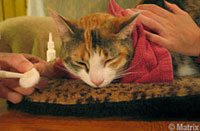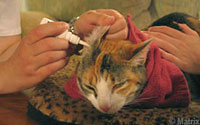Medicating a Cat's Ears

Your veterinarian may prescribe medication for ear infections or other ear conditions in your cat. As long as the kitty is not in too much pain, she should tolerate ear treatments quite well.
Before medicating a cat's ears, it's usually recommended to clean them out. This is so that debris is removed and the medication can then contact the ear canal properly. Check with your veterinarian to determine if that's the case for your cat.
Ask your veterinarian to demonstrate ear cleaning and medicating while you and the cat are still at the veterinary facility, and try ear cleaning yourself while there, too. That way, any awkward aspects of the procedure can be worked out, and your questions can get answered.
Tips for Ear Medicating in Cats
Here are some tips to keep in mind when medicating your cat's ears:
- Have the medication within easy reach.
- Warm it up to room temperature before instilling it to help reduce the “cold shock” reaction.
- It is ideal to have a family member or friend help by holding your cat. A soft bath towel wrapped snugly around your cat's body, with only the head left out, can help, too. Steadying the cat will make her feel more secure and keep her from skittering away. A towel (or your capable assistant) can also help keep those claws out of commission.
- Be gentle when handling your cat's ears because they are delicate and highly sensitive.
- If you are going to be handling your cat for medicating ears regularly and she is the scratching type, keep her claws trimmed short or covered with Soft Paws®, so the likelihood of a scratch to you or your assistant is reduced.
- Do not proceed if you think your cat might bite you or your assistant. Contact your veterinarian for help.
- Do not shove the medication nozzle tip down deep into the ear canal because it may go too far and damage or tear the ear canal lining or ear drum if your cat moves quickly and vigorously.
- Avoid hitting the small ear hairs with the tip of the medication nozzle because this tends to make cats shake their head—it tickles.
- Avoid pulling out and up on the ear. This straightens the ear canal out. That can lead to the nozzle going too far in—take the ear up and over the head instead.
- As you instill the medication, take a little bit of the loose skin located in the area between the ears and steady it between your fingers of the hand you are holding the ear with. This helps you move along with the cat if she suddenly moves. Otherwise, you might find yourself pulling the ear as she moves away, hurting her.
- Count the number of drops prescribed to avoid under-medicating or overdosing.
- Give all doses prescribed.
- Massage the base of the ear gently after the medication is instilled. This will help distribute the drops of medicine evenly over the tissues.
- Choose a location for the ear treatment that has a surface that can be easily cleaned. Cats will commonly shake their head vigorously after the medicine has been instilled. This can lead to droplets spraying around the area—your clothes, fine rugs, furniture, and drapes are all easy targets! Some medicines stain, so it is essential to watch out for valuables or delicate fabrics.
- If your cat seems to be particularly sore when the drops go in or right after treating, contact your veterinarian promptlybecause this might indicate a broken ear drum or ear canal ulcers. If the medication goes too deep, it can lead to serious pain. Also, some cats have sensitivity or even an allergy to some ear preparations. In that case, your veterinarian will try another brand or type of therapy.
- Praise your cat when she sits quietly for the procedure.
Feline Ear Cleaning Procedure
Step 1: First, clean the ears.

Step 2: Medicate.

Instill drops as per prescription label with ear held up and over the head—using extra fingers to gently grasp the skin between the ears to help you follow the ear/head if she moves suddenly.
Massage the base of the ear to distribute the medication evenly.
You May Also Like These Articles:
Does Your Cat Have Whisker Fatigue?
Notice: Ask-a-Vet is an affiliated service for those who wish to speak with a veterinary professional about their pet's specific condition. Initially, a bot will ask questions to determine the general nature of your concern. Then, you will be transferred to a human. There is a charge for the service if you choose to connect to a veterinarian. Ask-a-Vet is not manned by the staff or owners of CatHealth.com, and the advice given should not delay or replace a visit to your veterinarian.



